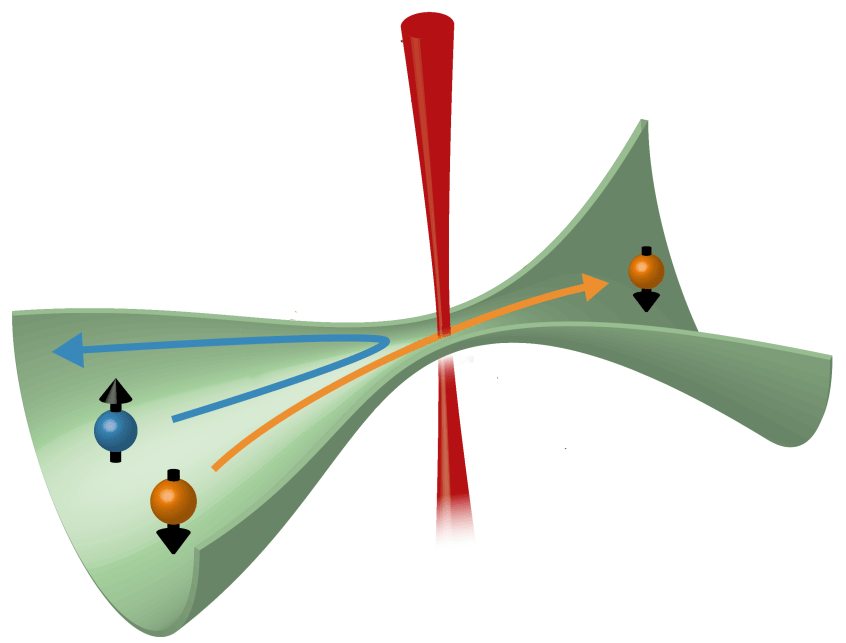Nov 11 2019
A research group led by Tilman Esslinger has demonstrated simultaneous control over spin and transport properties of cold atoms. The study has helped establish a framework for investigating concepts in solid-state physics and spintronics.
 Creating spin-polarized currents through an atomic quantum point contact. An optical beam (red) introduces an effect equivalent to applying a magnetic field inside an optically defined structure in which the atoms move (green). Atoms in the energetically lower spin state (orange) can flow while atoms in a higher spin state (blue) are blocked. Image Credit: 10.1103/PhysRevLett.123.193605.
Creating spin-polarized currents through an atomic quantum point contact. An optical beam (red) introduces an effect equivalent to applying a magnetic field inside an optically defined structure in which the atoms move (green). Atoms in the energetically lower spin state (orange) can flow while atoms in a higher spin state (blue) are blocked. Image Credit: 10.1103/PhysRevLett.123.193605.
Charge-neutral atoms can be put to use in one of the more unpredicted applications: They can be used to simulate the way electrons fundamentally behave. In the last few years, the group led by Tilman Esslinger from the Institute of Quantum Electronics has mastered a platform where atoms cooled to temperatures very near to absolute zero are passed through one- and two-dimensional structures, under the influence of a potential difference.
This technique can be employed to perform in-depth studies of phenomena that occur in mesoscopic electronic systems, more specifically quantized conductance.
In a couple of articles published recently in Physical Review Letters and Physical Review A, postdoc Laura Corman, former PhD student Martin Lebrat, and their colleagues from the Esslinger group have reported that through their transport experiments, they have pioneered control over another quantum property of the atoms—their spin.
To the transport channel, the researchers added a strongly focused light beam. This light beam induces local interactions that are quite similar to exposing the atoms to a strong magnetic field.
This results in the removal of degeneracy of the spin states. This, in turn, serves as the foundation for an efficient spin filter: while atoms of one spin orientation are rejected, those of the other spin orientation can pass freely.
Most significantly, although the atoms are lost when an additional light field is applied, such dissipative processes do not annihilate the quantization of conductance. The ETH scientists reproduce this experimental discovery through numerical simulation and demonstrate its validity using an extension of the Landauer–Büttiker model, the most important theory for quantum transport.
The efficiency of the atomic spin filter exhibited by the Esslinger group is in accordance with that of the best analogous elements for electronic systems. This, in combination with the exceptional controllability and “cleanness” of the cold-atom platform, paves the way for fascinating new points of view for investigating deep into the dynamics of quantum transport.
Specifically, since it is possible to tune the interaction between the atoms, the platform offers access to spin transport of quantum systems that are strongly correlated. This system, which is otherwise hard to analyze, is of great practical and fundamental interest, more particularly for applications in spintronic devices, as well as to study fundamental phases of matter.